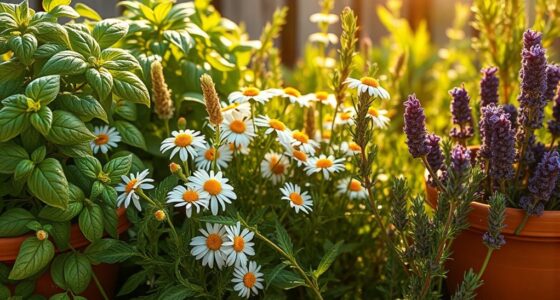Mint can be a great addition to your garden for its culinary and pest-repelling benefits, but it’s also very invasive. To keep it under control, plant it in containers or designated borders, and prune regularly. Avoid planting it directly in flower beds where it can take over other plants. With proper management, mint remains a valuable herb, but if you overlook these tips, it may become more foe than friend. Discover how to balance its benefits and risks.
Key Takeaways
- Mint is versatile and beneficial for culinary, medicinal, and pest-repellent uses when properly managed.
- It tends to spread aggressively, potentially overtaking other plants if not contained.
- Plant mint in containers or designated borders to prevent invasive growth and maintain control.
- Its strong aroma naturally deters pests, reducing the need for chemical pest control.
- Regular pruning and physical barriers are essential to balance its benefits with its invasive tendencies.

Mint may seem like a helpful herb, but it can quickly become an invasive problem if not managed properly. Its herb versatility makes it a popular choice for many gardeners, as you can use it in teas, desserts, salads, and even in homemade remedies. However, this same versatility can turn into a double-edged sword because mint tends to spread aggressively. Once established, it can take over flower beds or garden plots, crowding out other plants and making maintenance a challenge. If you’re considering planting mint, you need to be aware of its tendency to escape containment and plan accordingly.
One of mint’s notable advantages is its pest resistance. Unlike many other herbs, mint naturally repels certain pests, thanks to its strong aroma. This can save you time and effort in pest control, reducing the need for chemical treatments. Its scent acts as a natural deterrent for aphids, ants, and even some beetles, making it an attractive addition to vegetable gardens or herb patches. But, while pest resistance is a benefit, it shouldn’t overshadow the fact that mint’s rapid spreading can cause problems elsewhere in your garden.
To manage mint’s invasiveness, many gardeners recommend planting it in containers or designated borders. Using a pot with a drainage hole and burying it partially in the ground can contain the roots and prevent the plant from spreading unchecked. This approach allows you to enjoy its herb versatility and pest-resistant qualities without risking the surrounding plants. If you plant mint directly in the ground, consider installing a physical barrier like a buried edging or root barrier to keep it contained. Regularly pruning and harvesting mint can also help control its spread and keep the plant healthy.
Despite its invasive tendencies, mint remains a valuable herb if you take proper precautions. Its herb versatility makes it suitable for culinary and medicinal uses, and its pest resistance can help reduce the need for chemical interventions. Just remember, managing its growth is key. With thoughtful planning—such as planting in containers, using barriers, or maintaining regular pruning—you’ll be able to enjoy the benefits of mint without it overtaking your entire garden. When used carefully, mint can be a delightful and practical addition, but neglecting control can turn it into a troublesome invader. Proper containment techniques are essential to prevent it from becoming an invasive problem, ensuring your garden stays balanced and healthy.
Frequently Asked Questions
Can Mint Be Safely Grown Indoors Without Spreading?
You can grow mint indoors safely if you use container gardening and take steps for indoor pest control. Keep mint in a pot with drainage to prevent roots from spreading. Regularly check for pests and avoid planting mint near other plants to prevent invasiveness. By managing its environment carefully, you’ll enjoy fresh mint without it overtaking your space. Proper container gardening and pest control are key to keeping mint contained indoors.
What Are Natural Methods to Control Mint Invasiveness?
To control mint’s invasiveness naturally, try companion planting with herbs like rosemary or thyme, which can help suppress its spread. You should also install root barriers around your mint to prevent underground runners from taking over other garden areas. Regularly pruning and harvesting mint encourages healthy growth, while these methods keep it manageable without chemicals. This way, you enjoy mint’s benefits without letting it become a garden pest.
Does Mint Attract Beneficial or Harmful Insects?
Imagine mint as the neighborhood gossip—always attracting a crowd. It draws beneficial insects like pollinators, helping your garden flourish, but beware of pest attraction too. While pollinator support boosts your garden’s health, harmful bugs may also come sniffing around. So, plant mint thoughtfully to enjoy its benefits without inviting trouble, turning your garden into a buzzing paradise rather than a pest party.
How Does Mint Affect Nearby Plant Growth?
You notice that mint can impact nearby plant growth through root competition and allelopathic effects. Its vigorous root system often outcompetes other plants for nutrients and water, which can stunt their growth. Additionally, mint releases chemicals that may suppress the development of neighboring plants, making it a challenging companion in your garden. To prevent this, consider planting mint in containers or designated areas to minimize its influence on other plants.
Are There Specific Mint Varieties Less Invasive?
If you’re concerned about invasive species in your herb garden, some mint varieties are less invasive than others. For example, apple mint and chocolate mint tend to spread less aggressively, making them better choices for controlled planting. You can keep mint contained by planting it in pots or designated areas. By selecting these less invasive varieties, you enjoy fresh mint without risking your garden’s balance or disrupting nearby plant growth.
Conclusion
So, whether mint is your friend or foe depends on where you plant it. Think of it as a lively guest who can brighten up your garden but might also overstay its welcome if not managed. With careful placement, you can enjoy its fresh aroma and vibrant flavor without letting it take over your space. Remember, a little control keeps this spirited herb from becoming an unstoppable force, turning your garden into a balanced oasis.









